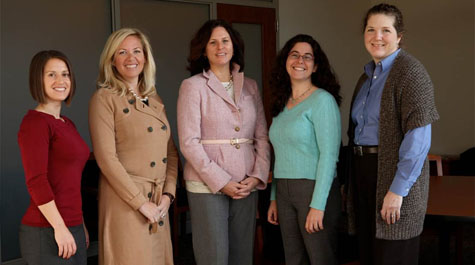Initiative to support, empower women STEM faculty
A group of five William & Mary Psychology and Neuroscience professors recently received a $580,000 grant from the National Science Foundation to benefit women faculty in science, technology, mathematics and engineering (STEM) disciplines.
The three-year grant will sponsor career development activities, research and assessments for female STEM faculty not only at William & Mary and the Virginia Institute of Marine Science, but Thomas Nelson Community College and Richard Bland College as well. The initiative, titled Women in Scientific Education (WISE), addresses the attrition of women in science at each stage of the educational process, a phenomenon known “the leaky pipeline”, by providing funds for career development.
“There’s a discrepancy between males versus females who get their bachelor’s degrees in science-related fields and then who go on to get their Ph.Ds. There is an even bigger gender difference on who gets hired as faculty and then receives tenure,” said Assistant Professor Cheryl Dickter. “For women, maintaining a career in STEM drops off over time, and so the idea is to investigate why and figure out how we can help at each stage.”
The WISE initiative is being directed by Associate Professor Jennifer Stevens, Dickter, Assistant Professor Catherine Forestell, Professor Pamela Hunt and Visiting Assistant Professor M. Christine Porter.
Stevens said that WISE will fund a variety of career-development activities, including workshops on topics such as writing, leadership and challenges that women in STEM disciplines face.
The initiative will also fund an annual leadership forum, an annual retreat, and four symposia each year.
“This grant is to career develop and empower female faculty in the STEM disciplines,” Stevens said.
In addition to career development, WISE will also provide resources for research, said Forestell. Approximately $50,000 a year has been earmarked to provide faculty with research and transition grants.
“We are quite aware – as women – that women are typically caretakers,” said Forestell, adding that women are often responsible for the care of children and aging parents. “That might interfere with their ability to be productive researchers, so this grant is meant to provide a transition for them as they return from some of those family responsibilities.”
The grants will also provide community college faculty members, who spend most of their time teaching, with rare access to research opportunities.
“Money is tight with big, national grants, so if we can provide women with access to these resources, it encourages and empowers them,” said Forestell.
In addition to career development and research opportunities, WISE will also allow researchers to conduct several assessments related to women in STEM disciplines, said Dickter.
One such assessment will look at how women in STEM disciplines perceive themselves.
“Research suggests that even women who are at really good schools and are tenured or tenure-track faculty still may have negative implicit perceptions of themselves as women in science,” said Dickter.
In order to examine those perceptions, the researchers will conduct several comparisons, looking, for example, at women who will be participating in WISE versus women who will not, women who are in STEM disciplines versus those who are in non-STEM fields and women faculty versus men.
“We are looking long term to see if we can improve those implicit attitudes about women in science over the course of the three years,” said Dickter.
Stevens said that it is important that the NSF, as a national funding agency, funded this grant to support and fund research for women in STEM disciplines.
“They recognize the discrepancy between the genders, and they’re promoting women in the STEM disciplines by funding these initiatives,” she said.
She added that it’s exciting that William & Mary is partnering with two community colleges for this grant and expects the grant to benefit students.
“We are a relatively small school, and it is tough for us to get funding” she said. “In comparison to large institutions, we created a community for fostering development, collaboration, and mentorship by partnering with our community colleges and developing a critical mass. This will have long-term effects for our own faculty and should have down-stream effects for role-modeling with the students.”
William & Mary is already becoming known nationally as a producer of young women scientists. The College was recently featured in a national Associated Press story “Women Making Slow, Sure Strides In Science, Math.” The story highlights Associate Professor of Chemistry Elizabeth Harbron and her work with young women scientists at the College.
In the article, Harbron extolls the importance of having women role models in the STEM disciplines.
“For some students, if they don’t see people like them represented in the faculty, it just becomes less appealing, I think,” she said in the article. “We are reaching a critical mass of women scientists, but we still have a long way to go in creating a science faculty that looks more and more like our students.”
















